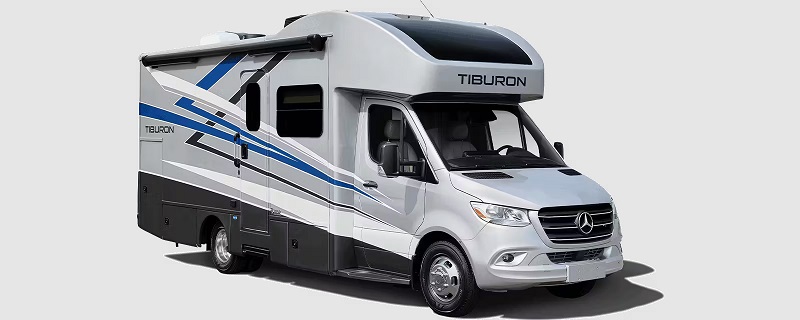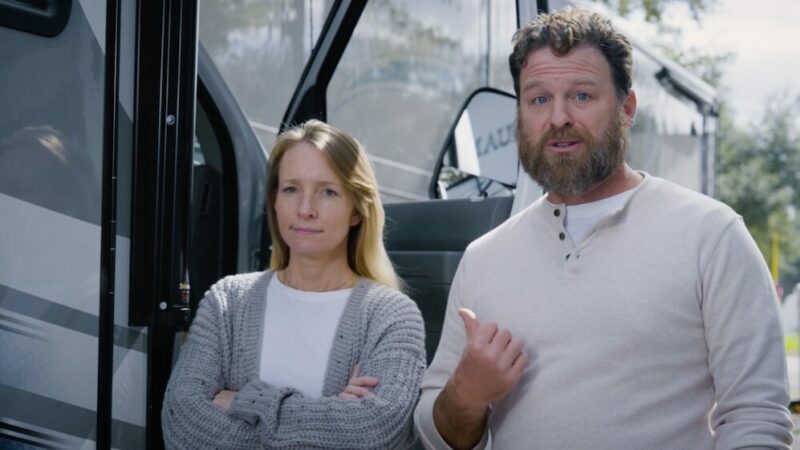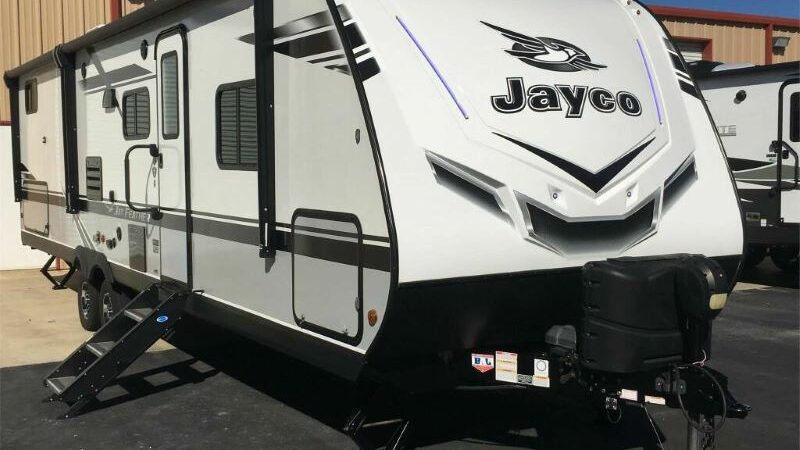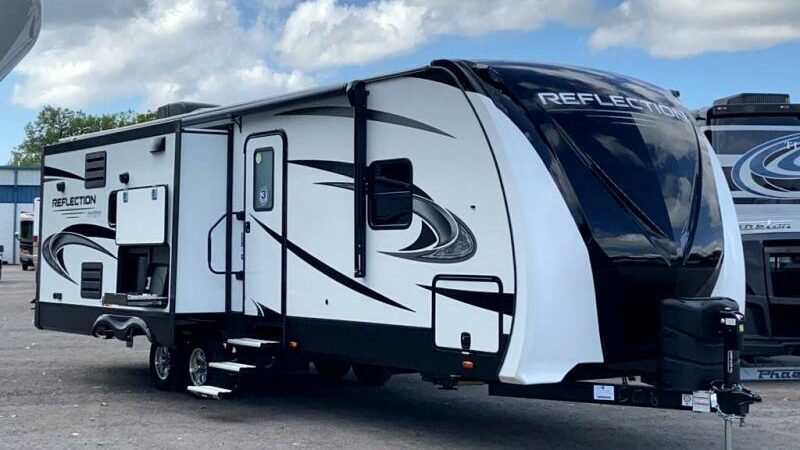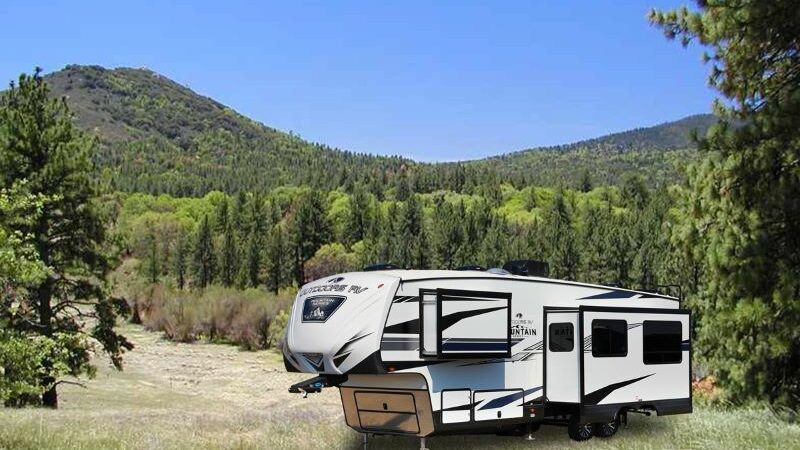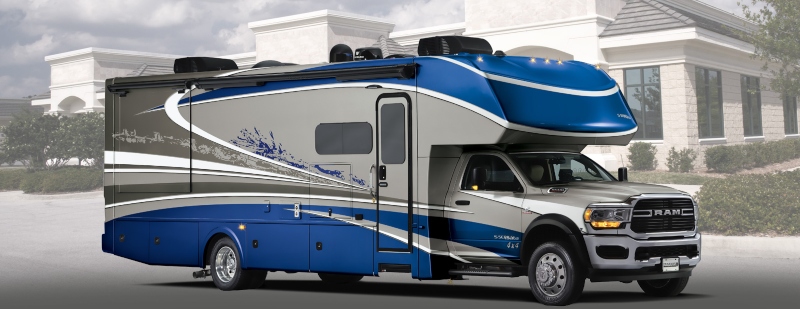10 Tips For Driving A Motorhome In The Winter
Thanks for your support! If you make a purchase using our links in this article, we may make a commission. And, as an Amazon Associate, I earn from qualifying purchases. See the full disclosure here.
Driving a motorhome in the winter is not an envious task, especially if you are moving through an area with extreme elevation changes. It’s scary driving in adverse winter weather conditions with a car, much less a massive home on wheels.
I’ve driven our Class A RV, and our Class C RV, in the snow on several occasions, and they were white-knuckle experiences every time.
While there are physical aspects of a motorhome that make it a little easier (they’re awfully heavy), there are drawbacks too, just like anything else. If you’re from southern states, both in the southeast and the southwest, this might be your first rodeo on a snow-covered, back-mountain road.
If you live in Denver, you probably drive in snowy, elevated conditions better than most people drive cars. But alas, cars and motorhomes are not the same. Before you get too ahead of yourself and leap without looking, let’s cover some tips and precautions for driving a motorhome in winter weather.
Can You Drive a Motorhome in the Snow?
While it’s not an enviable task, you can drive a motorhome in the snow. I’ve done it myself on many occasions. If we’re talking blizzard-level snow conditions, it’s always best to exercise caution and remain in place until the weather is clear, and the roads are nice and salty.
In fact, if snow is on the road, exercising caution is best. In busy areas, salt trucks will come through pretty quickly. Throughout rural areas, you may have to wait for the closest city or town to get to its suburbs and rural areas.
Without chains on your tires, motorhomes are no more equipped for snowy road travel than regular vehicles are. If you’re new to driving a motorhome, most have rear-wheel drive, so it’s something you’ll need to get used to long before you try your first snow escapade.
Unfortunately, rear-wheel drive is not the best when it comes to motorhome control in icy weather. So, with the understanding that motorhomes are drivable in snowy conditions, it’s imperative that you log some serious hours in your motorhome first. Before you attempt to drive in winter weather you’ll want to be comfortable with your rig.
There’s always the chance that you get caught out in the snow, so it’s a good idea to have your weather apps ready and pay attention to weather patterns as they move throughout your area.
My Worst Experience Driving Our Class A in the Snow
My worst experiences driving our Class A motorhome in the snow happened in January and February of 2022. I had to take our rig to the Thor Manufacturing plant in Elkhart, Indiana and I had to deal with snow on the way there in January and on the way home to Maryland in February.
The drive from Maryland to Elkhart required me to drive through three inches of fresh snow in Elkhart. I was pleasantly surprised at how well the rig handled until I came to a downhill section of road with a red light at the bottom of the hill. I managed to gear down to Low and pumped my brakes to stop in time.
The drive home from Elkhart was not so easy. I was driving on the Pennsylvania Turn Pike when it started to snow hard. Then my GPS suddenly re-routed me because of an accident ahead. So, I had to traverse many side roads through the Alleghany Mountains. I knew I was in serious trouble when I saw a sign that said, “You have reached the highest point in PA!”
Yikes! I was freaking out because I knew I had a long way to go downhill from the summit of Mount Davis. It was the scariest drive I ever! Luckily for me, the route had been salted but the shoulder of the road was under four inches of snow. So, I had no margin for error while I descended the mountain.
I used the tips we provide in the remainder of the article (except for Tips 1 and 4) to explain how to drive in winter conditions.
Are Motorhomes Good in the Snow?
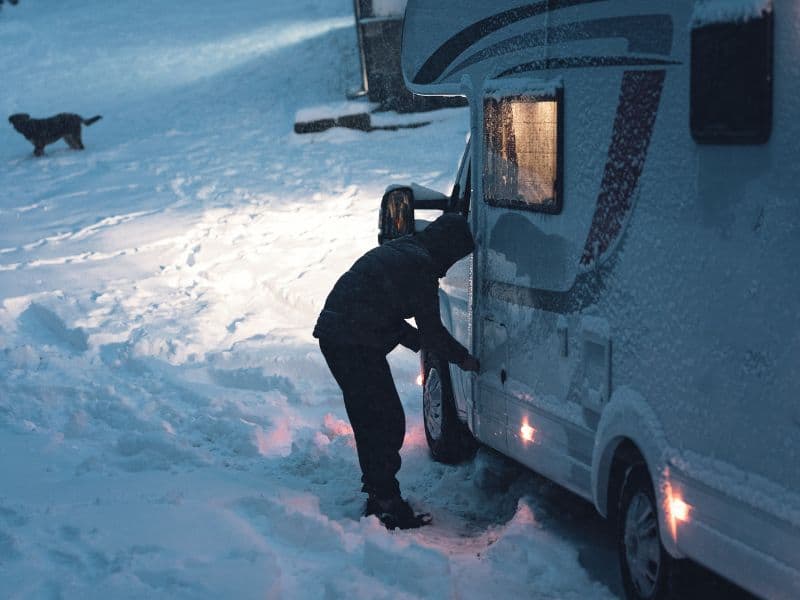
Overall, not really. The benefit of having a much heavier vehicle on the road is undeniable. However, without chains on the tires, rear-wheel drive, a different braking method for unexpected sliding, and enough of a top-heavy load to throw things off balance in a hurry, it’s not the safest thing in the world.
Plus, laying over a motorhome will probably have much more drastic consequences than flipping a car on its side. You have to drive slower, take more time to stop, learn to pump the brakes rapidly in a slide, turn off your exhaust brakes (diesel pushers), and pull over whenever the conditions demand it.
It’s not worth risking a potential accident just to reach your destination in time. Getting stuck in a motorhome will not be the most magnificent experience of your lifetime. If you haven’t properly prepared for such eventualities, it’s even worse. Of course, we’ll cover all of that and more below.
10 Tips for Driving a Motorhome in the Winter
Keep in mind, these are some great tips for driving a motorhome in the winter. However, no matter how many tips we lay down for you, it’s not a substitute for exercising a high degree of caution before you hit the road.
1. Avoid Bad Road Conditions
The best way to exercise caution is to avoid getting out and about, period. It’s even easier to make this decision if you’re traveling through back roads and rural areas, where it takes much longer to clear the roads after a winter storm.
Your decision on whether or not to drive may change depending on your location. For example, Minnesotans know their business regarding snow and will clear the roads a lot faster than southern states caught in a freak snowstorm.
Northerners used to snowy conditions will generally drive better on icy roads (though this isn’t always the case) and northern states are all about rapid response, preventative maintenance, and preparation throughout the coldest months of the year.
Sometimes, however, the best way to drive your motorhome in the winter is to park it and avoid driving it at all.
2. Drive Slow
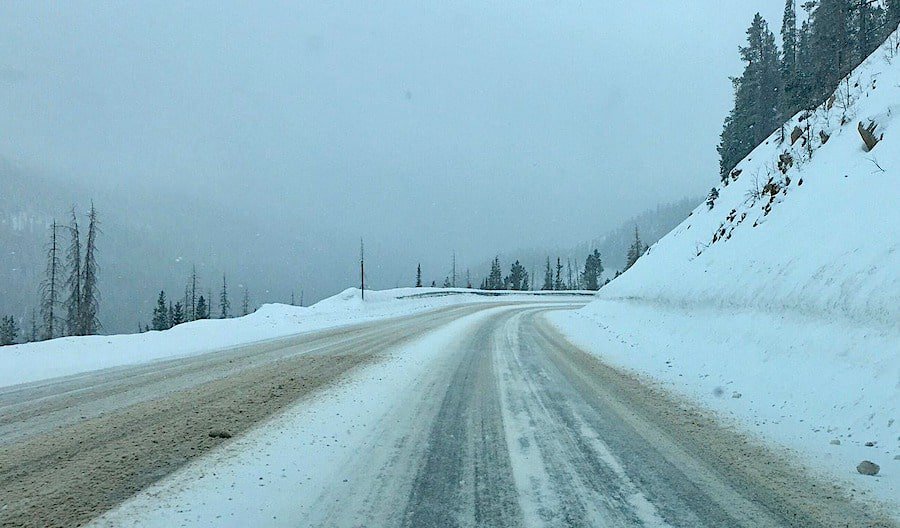
This kind of goes without saying. Most people slow down in a thunderstorm, and a snowstorm is even more precarious. It’s especially bad well into the evening and first thing in the morning.
As the snow falls, it typically melts on the asphalt or concrete. As nighttime arrives, the roadways cool even more, freezing any surface water or vapor just above the road’s surface. The times to strongly consider staying off the road when there is snow on the ground are the following:
- Foggy mornings or evenings
- Rain that precedes or follows snow
- First thing in the morning
- Late in the evening
- When the sky is clearing and temps reach just above or at freezing
- Bridges
- Low areas and valleys
Low areas and valleys tend to be cooler because cold air is denser than warm air, easily settling into low-lying areas. Fog creates what is called, “icing,” mostly on roadways. This is because of the fog feeds moisture to the surface of the road when the temperatures are at or close to dew point temperatures.
That moisture then freezes on the surface of the road. Bridges are notorious for freezing despite above-freezing temperatures, thanks to the wind chill effect.
While this is all a bit scientific for a motorhome article, it’s important to pay attention to these weather factors and temperature phenomena before you decide whether to drive or not.
3. Make Sure You Have Good Tires
Bad tires are bad in every kind of weather, even on a bright, sunshiny day. Unfortunately, they’re terrible when trying to travel through snow. The average longevity of RV tires is anywhere between 3 and 6 years. A lot of that depends on how long you drive it as well.
Know your tire pressure at all times and keep it within one psi. As part of your traveling gear, you should have a compressor for keeping your tire pressure topped off. You should keep up with regular tire rotations and keep the tires covered whenever the motorhome goes into storage.
Make it a habit to inspect the sidewalls before you head out, each and every time. It doesn’t take long, and you may be very glad you did it.
4. Stay On Main Highways
This is an obvious tip, and we’ve already elaborated on it a bit at the beginning of the article. While northern states typically clear snow faster than southern states, the rural roads are the last to be cleared.
In fact, some back roads may not garner any attention at all, especially if there’s not much out that way. If you’re one of those drivers who loves to go off the beaten path and find faster ways to your destination, snow time is time to reconsider.
Stick to the main roads, which are cleared quickly and salted to keep black ice from cropping up.
5. Have an Emergency Kit
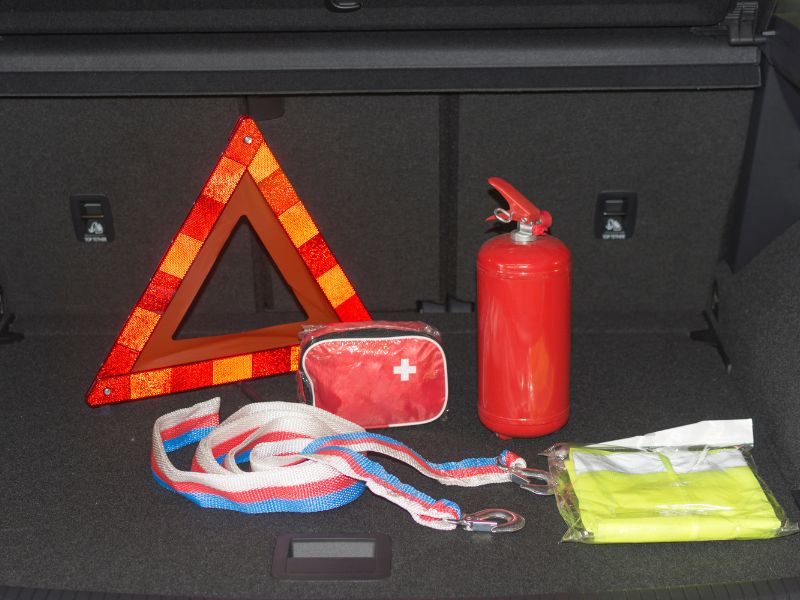
Flares are an excellent addition to your kit and, if you don’t like the idea of these flammable devices in your motorhome, you can always opt for the LED versions. They’re actually quite bright.
We keep a roadside emergency kit in both of our RVs. You don’t need it until there is an emergency, so it’s best to keep one on board and hope you never need it.
There are a few more things worth adding as well.
- Gloves with plenty of grip and a second, stronger pair
- Thermometer
- Thermal blankets
- Pocket knife
- Flashlights and/or headlamps
- Air compressor
- Power banks
- Tow strap
- Hammer
- Collapsible shovel
- Ice scraper
- Duct tape (so you can properly face down any situation)
- Tools for mechanical or tire repair
You can always add and subtract supplies, depending on the season as well. For instance, you obviously won’t need thermal blankets in the summer.
6. Use Your Four-Way Flashers
There’s a caveat here. Only use your four-way flashers if you’re stopped on the side of the road or as a warning to other drivers that you’re going way too slow. This will let drivers know to approach you cautiously and slow down.
However, just having your flashers on while driving at speed is often as much of a distraction as it is a warning. It could cause the very thing you’re hoping to avoid.
For those curious about using flashers in heavy, heavy snow, you should use them only once you are safely off the side of the road. It’s not a good idea to keep driving in a blanket snowfall.
7. Use Chains if Allowed
When you install chains on a motorhome’s tires, they must go on the drive wheels. In almost every case, that will be the outermost rear wheels (in case you’re placing them on dualies).
Chains are a must in some areas of the country. While we were in Colorado, we saw many areas on the side of the highways for vehicles to pull over and install chains.
That doesn’t mean you can’t place them on all the other tires because you can. The drive wheels are just the most important ones. If you don’t put chains on the drive wheels, you’re wasting your time.
The chains should run from edge to edge, over the tread, and will cover your sidewall in either a spider web or ladder appearance. To install them correctly, you’ll have to drive forward or backward a little bit, to catch the section of tire sitting on the road.
That’s why installing them on flat, level ground is always a safe bet. It’ll make your life a lot easier. Make sure they’re nice and tight. Tire chains should come with a tensioner just for this.
Most places that sell tire chains are pretty straightforward with their customers. If the road is so bad that you need chains, you should probably park the motorhome for the day.
8. Shorten Your Travel Days
Look over your typical drive time and strongly consider trimming the edges. As we mentioned above, driving a motorhome in the winter is fine, with the exception of early morning hours and late evening.
Travel during the day, when the temperatures are up. It’s easier to tackle snowy conditions in the daylight anyway. Spending too long on the road runs the risk of getting caught in a snow ambush after the sun goes down.
With shorter days throughout the winter months, it only makes sense to trim down your travel time anyway.
You would be surprised how much driving in the show affects you physically while driving a big motorhome. I get so stressed out I get a stiff neck and shoulders after driving in the snow. So, I learned to shorten my drive times and take breaks more often.
9. Ensure Your Defrost and Wipers are Both Working Well
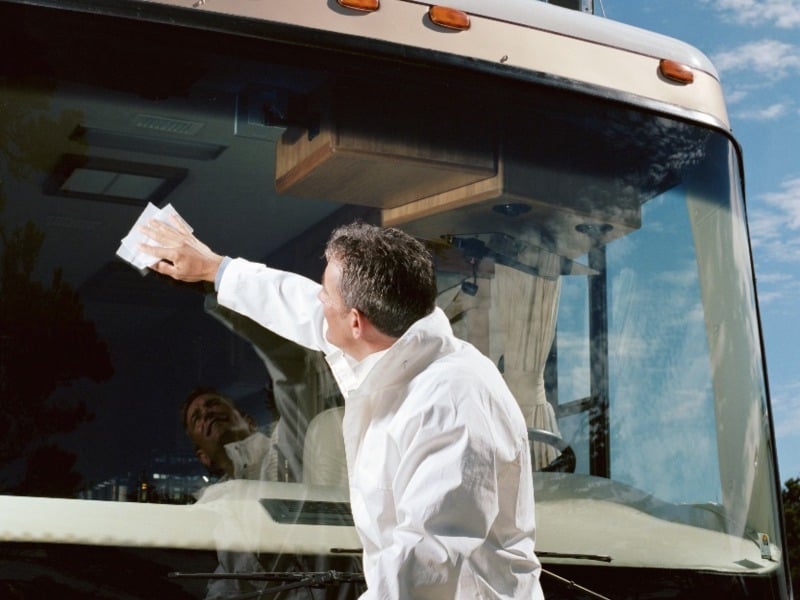
This is one of those preventative maintenance tips that goes for 365 days. Rain will cause your windows to fog up without the defrost on every bit as much as a cold windshield will collect ice without the heat.
Since you’ll need heat, your radiator and all of your tubes need a proper inspection. Your anti-freeze runs through a heat pump, which heats it as a side effect. If your heater isn’t working, that hot anit-freeze is only good for keeping the engine cool.
Windshield wipers should wipe your windshield clean and consistent with each passing. If you see the blades starting to fray or you see missed streaks as it passes over the windshield, it’s time for a replacement.
10. Increase Your Following and Stopping Distances
This is something that newbie motorhome drivers often take a long time to get used to. A motorhome is much heavier than a car, even an SUV, making the stopping distances much longer.
On nice days, the four-second rule is a good one to follow. You should be able to count off four seconds between the car in front of you.
To test this out, I use any sign as a marker. Once the car ahead of me passes the sign, I start counting slowly and see how many seconds it takes me to reach the same sign. This helps me to establish a safe driving distance from the car in front of me.
In snow, you should double that. Ease up on the speed and take it easy. It’s tempting to go with the flow of traffic. However, those people are not driving motorhomes. Let them go around you, remain calm, and don’t let your foot turn to lead.
Remember, you can drive the same speed as a car in the snow but you can’t stop like a car.
Do They Make Winter Tires for RVs?
Most RV tires are all-season tires. However, there are a few tires out there that carry the “snow tire” label.
- Goodyear Wrangler Silent Armor Pro
- Bridgestone Blizzack
- Pinelli Scorpion Ice and Snow
There are markings on RV tires that you should look for, if you want something better suited for the cold season. These come in the form of a snowflake or mountain icons, along with the letter S (usually next to a letter, M, for mud).
Regardless of the tire you decide to go with, the best winter tire is only as good as the preventative and standard maintenance you apply to it. Tires for driving a Class A motorhome in the winter are few and far between. Those who have Class Cs and Bs will have an easier time of it.
Also, pay attention to state laws. Some require you to have chains on your tires in snowy conditions, while some allow them for more than just throughout a heavy snowstorm.
Can You Live in an RV in the Winter?
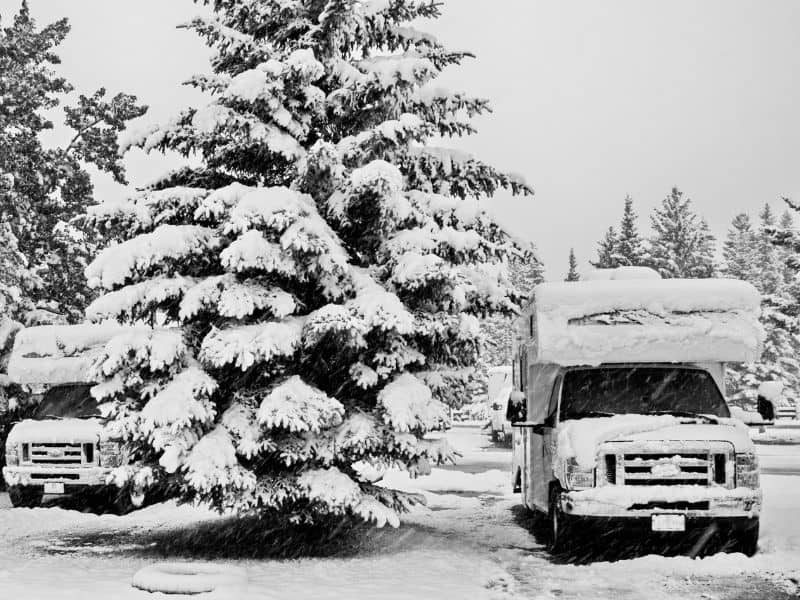
You certainly can and a lot of people do just that. Those who have retired and set out for a life on the road, along with those who work on the road and travel all year.
If you’re looking for an RV that withstands the deep chill of winter better than any other, your best bet is a four-season motorhome. As the name implies, the necessities through the winter are built in during the manufacturing process.
Insulated skirting is a huge factor throughout the winter months and you have a lot of options where that’s concerned. If you’re not driving your motorhome around in the winter, consider a DIY, 1″ foam board insulation skirt, or you can order the professional stuff from EZ Snap or AirSkirts just to name a couple.
Make sure you stock up on the propane or think outside the box for your heating needs, as propane is in high demand in the colder months.
Final Thoughts On Driving a Motorhome in the Winter
It’s worth mentioning again that the best time to drive a motorhome in bad winter conditions is not to do so at all.
Navigating a motorhome through a flurry, a snowstorm, over frozen bridges, and across large stretches of road that may or may not have hidden patches of black ice, isn’t safe by any means.
Get some good tires, practice preventative maintenance, maintain an emergency kit, and keep an eye on the weather to help ensure your and your family’s safety, even if you get caught up in unexpected snow.
Related Reading:
– Is RV Driving School Worth The Money?
– Should I Leave My RV Plugged In All Winter?
– Can You Use A Camper In The Winter?
– Can You Sleep In An RV While Driving?

Source: https://rvblogger.com/blog/tips-for-driving-a-motorhome-in-the-winter/


